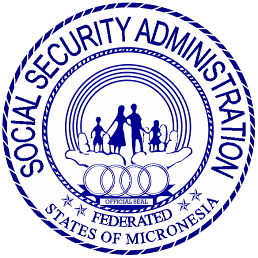Retirement
Social Security is a worker-employee-government insurance program designed to protect you and your family while you work and after retirement. The Social Security Benefits do not intend to replace your earnings, but it will ease the burden the family may experience during sudden loss of income. Social Security is the only pension plan available in the FSM.
Effective January 01, 2011 New Retirement Law Requires that a fully insured wage earner who turns 60 years old on or after the effective date will become eligible for 50% of his or her total calculated benefits with the option of continued employment -excluding earnings test adjustments. This goes on until the new beneficiary reaches 65 years old, which will then make him or her become qualified for 100% of his or her total calculated benefits. However, if he or she decides to continue employment after reaching age 65, earnings test adjustments will be applied to their benefits again.
In order to qualify for retirement, every person must satisfy the following requirements:
- Fully insured with at least $2,500 in total contributions (a person can pay the difference if his or her contributions is less than $2,500 in a one-time payment to earn eligibility);
- Has a total coverage of at least 50 quarters.
- Attained age 60 years for 50% of total benefits without earnings test adjustments, and age 65 for 100% of total benefits subject to earnings test.
- Filed application for old age insurance and shall be entitled to an old age insurance benefit for each month, beginning with the month of which both paragraphs (1) & (2) are satisfied and ending with the month preceding the month in which he/she dies.
Fully insured means that a person’s cumulative quarters of coverage is at least as great as the number of years calculated from the later of the date the worker turned age twenty one (21) or June 30, 1968, to the date the worker attains age sixty (60), becomes disabled or dies. Partial years shall be counted as whole years. For example, 37.25 years would be rounded up to 38 years. In any case, a person cannot be fully insured if he or she has less than 12 quarters.
The FSMSSA was established on July 01, 1968 and therefore 1968 is significant because that is the starting point in counting the eligibility of individuals for benefits. We must also consider two additional years needed for the calculation of the fully insured process: the year an individual turns age 21 and the year that individual turns age 60.
To understand how FSMSSA calculates the quarters of coverage for fully insured status, the illustration is as follows:
An employee was born on January 01, 1942; turn 21 on January 01, 1963 and turn 60 on January 01, 2002. By interpreting the law, we must compare the year the employee turns 21 and the year FSMSSA was established, whichever is later. In this illustration, we will use 1968 because it’s later than the date when the individual turns 21. The next step is to determine the year you turn 60, which is 2002.
2002 minus 1968= 34, fully insured
Earning Test.
Any individual who receives retirement, disability, or survivor benefit and who works in covered or non-covered employment shall have his/her quarterly benefit reduced by $1 for each $2 earned in a quarter, except there shall be no reduction for the first $300 earned in a quarter. The reduction shall be applied in one of the subsequent two quarters immediately after the quarter in which the earnings were made, or as soon as possible thereafter.
Evidence of Birth
A public, religious or family record of birth established before a person reaches the age of 5 constitutes preferred evidence of that person’s date of birth.
1. In most cases at least two of the following types of evidence shall be required:
- Birth Registration or Hospital Birth Record obtainable from the Office of Clerk of Court of the State or other public office where such records are maintained in your State or jurisdiction;
- Church Record of baptismal certificates, maintained by churches or religious groups;
- Employment record;
- Family record or personal Bible record;
- School record;
- Census record;
- Official Passport;
- Election record;
- Immigration record;
- Marriage record;
- Insurance policy or policies.
[*Census & Election records may be considered but may not always be considered convincing].
2. Other evidence of age. If you cannot obtain any of the preferred evidence listed above to prove your age, you may provide a sworn statement signed by a physician or midwife who was present at your birth.
In case there exists any reasonable doubt as to the accuracy of the evidence of age you provide, we may require you to provide other documentary material, prepared within five (5) years preceding the date you filed your application, which provides evidence of your date of birth.
 FSM Social Security Administration
FSM Social Security Administration 